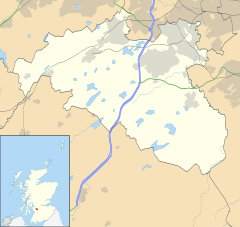Eaglesham
| Eaglesham | |
|---|---|
| Eaglesham shown within East Renfrewshire | |
| Population | 3,114 (2011 census) |
| OS grid reference | NS573519 |
| Council area | |
| Lieutenancy area | |
| Country | Scotland |
| Sovereign state | United Kingdom |
| Post town | GLASGOW |
| Postcode district | G76 |
| Dialling code | 01355 |
| Police | Scottish |
| Fire | Scottish |
| Ambulance | Scottish |
| EU Parliament | Scotland |
| UK Parliament | |
| Scottish Parliament | |
Eaglesham is a village in East Renfrewshire, Scotland, situated about 10 miles south of Glasgow, to the southeast of Newton Mearns, south of Clarkston, and southwest of East Kilbride.
The 2011 census revealed that the village had 3,114 occupants, down 13 from the 2001 census (3,127). Eaglesham is distinctive in being built around the Orry, an area of common land about one-third of a mile in length, interspersed with trees and divided in the centre by the Eaglesham Burn. The ancient seat of the Earls of Eglinton. In the 17th century Eaglesham was a small market town. Today's village was founded in 1769 by Alexander Montgomerie, 10th Earl of Eglinton. It had at one time handloom weaving and a cotton-mill. Many of its buildings are grade 'B' or 'C' listed but, as a whole, the village is 'A' listed. Eaglesham was designated Scotland's first outstanding conservation area in 1960. It is likely that there has been a place of worship here since the 5th or 6th centuries.
The village is an example of an early Scottish planned village.
There have been several suggestions as to the meaning of the name Eaglesham but the most likely explanation is that Eaglesham means kirkton or church town derived from the Gaelic word eaglais meaning church and the Saxon ham meaning hamlet or village.
The parish of Egglisham formed part of the district of Mearns, and together with other lands were bestowed to Walter FitzAlan, the first Seneschal (High Steward) of Scotland and founder of the House of Stewart, by King David I(1080-1153). Walter was the great-grandson of Alain Fitz-Alan, Dapifer (Steward) to the Archbishop of Dol in Brittany. During the 1160s Fitz-Alan began to distribute his lands amongst his Anglo-Saxon supporters and the lands of Egglisham were granted to Robert de Montgomerie, a knight descended from Arnulph de Montgomerie and fifth son of Roger de Montgomerie. Roger de Montgomerie accompanied William Duke of Normandy in his great expedition to England and supported him at the Battle of Hastings in 1066.
Situated in the Orry, is the Motte or Moot Hill, a flat-topped mound situated on the north-west bank of the Eaglesham Burn in the Orry used for judicial and local assemblies.
In 1361, Sir John de Montgomerie of Eaglesham and Eastwood married Elizabeth, daughter of Sir Hugh de Eglinton of that Ilk and niece of King Robert II. Sir John obtained the baronies of Eglinton and Ardrossan upon Sir Hugh's death in 1374. Afterwards the Montgomeries made Eglinton Estate their chief residence. In 1388, Sir John de Montgomerie captured Henry, Lord Percy at the Battle of Otterburn. It is traditionally believed that Sir John accepted a ransom for his prisoner who killed the 2nd Earl of Douglas and built Polnoon Castle on a small hillock on what appears to be an earlier motte. Polnoon castle was refurbished for occupation in 1617 but was ruined by 1676.
...
Wikipedia

